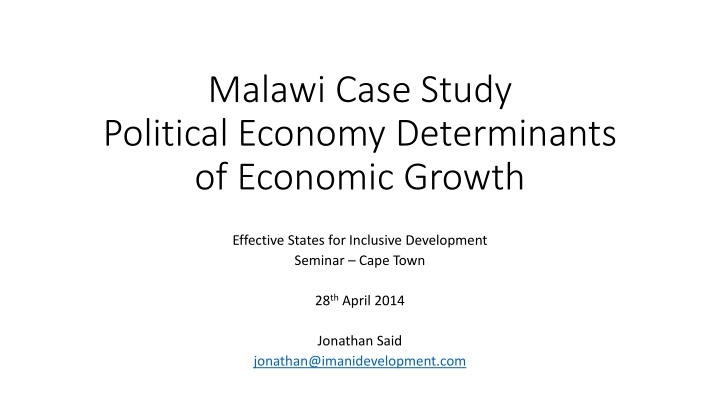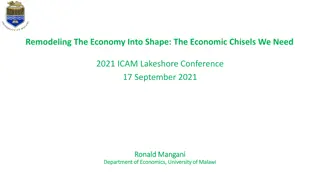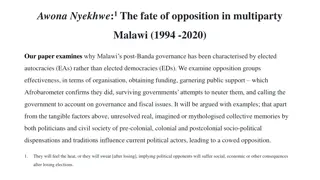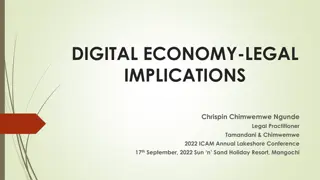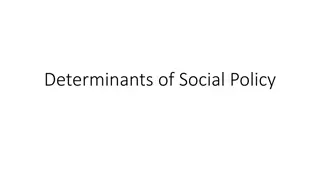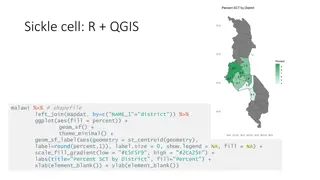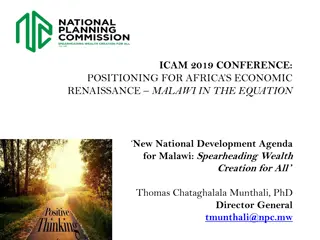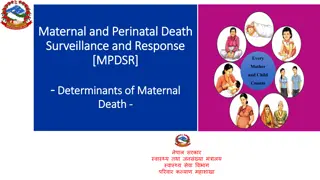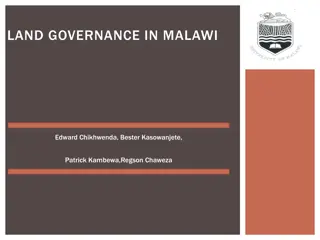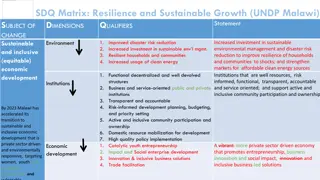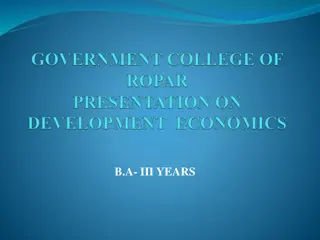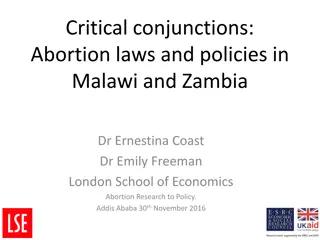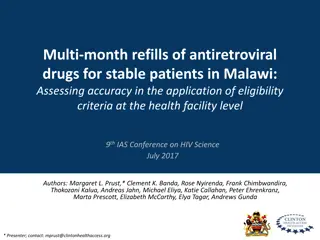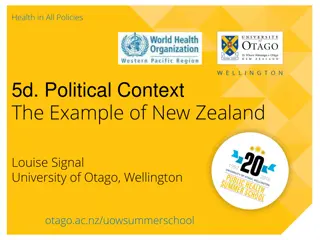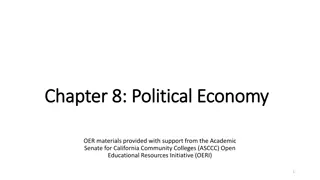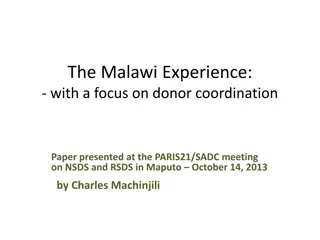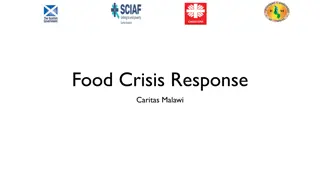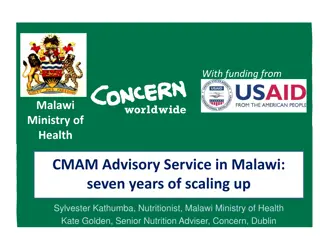Political Economy Determinants of Economic Growth: Malawi Case Study
Presenting findings from a seminar in Cape Town, this case study delves into Malawi's political dynamics impacting economic growth, historical evolution, growth acceleration, maintenance, and structural transformation. Analyzing the roles of institutions, political elites, and business in shaping growth processes since 1954, the study aims to contribute to understanding growth determinants in developing countries.
Download Presentation

Please find below an Image/Link to download the presentation.
The content on the website is provided AS IS for your information and personal use only. It may not be sold, licensed, or shared on other websites without obtaining consent from the author.If you encounter any issues during the download, it is possible that the publisher has removed the file from their server.
You are allowed to download the files provided on this website for personal or commercial use, subject to the condition that they are used lawfully. All files are the property of their respective owners.
The content on the website is provided AS IS for your information and personal use only. It may not be sold, licensed, or shared on other websites without obtaining consent from the author.
E N D
Presentation Transcript
Malawi Case Study Political Economy Determinants of Economic Growth Effective States for Inclusive Development Seminar Cape Town 28thApril 2014 Jonathan Said jonathan@imanidevelopment.com
Objective To present findings of Malawi Case Study
Overview 1. Introduction 2. Malawi s Growth and Structural Transformation Experience 3. Political History 4. Evolution of Deals Space and Situation Today 5. Political Dynamics of Growth Acceleration 6. Political Dynamics of Growth Maintenance 7. Conclusion
Overview 1. Introduction 2. Malawi s Growth and Structural Transformation Experience 3. Political History 4. Evolution of Deals Space and Situation Today 5. Political Dynamics of Growth Acceleration 6. Political Dynamics of Growth Maintenance 7. Conclusion
Introduction Study of institutions & growth Why do growth-impeding institutions persist in many LDCs Inadequate understanding of political dynamics of economic growth 3 unanswered questions: a) some countries initiate episodes of rapid growth while others suffer extended stagnation b) some countries sustain growth episodes while other episodes revert to stagnation or collapse? c) what characterises feedback loops between growth & institutions? Malawi case study to contribute to literature on political determinants of growth Application of conceptual framework developed by Sen (2012) & Pritchett/Werker (2012) Qualitative assessment of political factors that explain past & current growth processes in Malawi Analyses roles played by product space, structure of rents around product space & incentives of political & business elite in Malawi s growth regimes & structural transformation process since 1954
Overview 1. Introduction 2. Malawi s Growth and Structural Transformation Experience 3. Political History 4. Evolution of Deals Space and Situation Today 5. Political Dynamics of Growth Acceleration 6. Political Dynamics of Growth Maintenance 7. Conclusion
3 Structural Growth Breaks since 1955 Malawi s GDP per Capita (1955-2010), US dollar prices, and breaks filtered from 4 possible Bai-Perron Breaks $900 1st Growth Regime Regime 2nd Growth 4th Growth Regime 3rd Growth Regime $800 $700 $600 $500 $400 $300 $200 $100 $0 1955 1960 1965 1970 1975 1980 1985 1990 1995 2000 2005 2010 Source: Penn World tables 7.1 PPP Converted GDP Per Capita (Chain Series), at 2005 constant prices
First two growth regimes: stagnation then acceleration 1954 - 1964: Stagnation Final years of British Colonial Rule Monetary and Fiscal Policy ill-suited to Malawi. E.g. British Pound too strong Infrastructure expenditure focused on South Rhodesia (Zimbabwe) 1965 1978: Growth Acceleration Hastings Banda s dualistic development strategy Government intervention: construction of hospitals, capital city, schools, universities, roads etc 2 Government Companies ADMARC to buy agricultural products Press Holdings; involved in many sectors eg retailing, wholesaling, tobacco, banking, fuel, property, transport, pharmaceuticals, estate farming. Accounted for 1/3 of GDP at peak. Strategic Partners: targeted private sector investment; i.e. one winner (foreign companies) picked in each key sectors such as tobacco, sugar, tea, cotton, textiles, beverages etc
Export-led growth up to 1978 Percentage of Exports and GDP per Capita, US Dollar Prices 35 $900 $800 30 $700 $600 25 $500 $400 20 $300 $200 15 $100 10 $0 1960 1965 1970 1975 1980 1985 1990 1995 2000 2005 2010 Export (% of GDP) GDP Source: Penn World tables- PPP Converted GDP per Capita (Chain Series), at 2005 constant prices and World Bank World Development Indicators
and economic complexity increased, before collapsing Economic Complexity Index, Malawi 2.5 2.0 1.5 1.0 0.5 0.0 -0.5 -1.0 -1.5 -2.0 -2.5 1965 1970 1975 1980 1985 1990 1995 2000 2005 Source: The Observatory of Economic Complexity. Dotted lines represent Malawi s growth breaks. Note: 2.5 represents maximum level of complexity & -2.5 the minimum.
1979 2002: Decline External shocks triggered decline Oil price shock; collapse of commodity prices; structural adjustment programmes Exposed underlying structural constraints that gradually developed since 1960s Weak & deteriorating state capacity: emergence of predatory state Exclusion of majority of population from productive economy due to estate agriculture Weak market structures: monopolies & oligopolies Aid & debt dependence for social welfare Multi-party democracy from 1994 further weakened civil service due to less-centralised corruption at top, political appointments & poor wages Spread of HIV/AIDS & fiscal ill-discipline reduced capacity even further Debt undermined spending on public services & infrastructure Inability to deal with rain failures, so droughts were common Foreign investment, manufacturing, job creation & food security all undermined Private investment slowed: lending rate increased from 17% in 1980 to 56% in 2001
2003 to date: Another Attempt at Growth Acceleration New President centralised & controlled rent-seeking behaviour, got macroeconomic policy right & opened up to private sector Change in government served as conducive basis for growth factors to kick in from 2004 Return of development partners following the ousting of previous Govt Debt relief: total aid inflows equalled 93% of GDP in 2006 & 50% in 2007 Large fertiliser & seed subsidy programme which created maize surplus for 1st time since 1980s Health sector improvements Good rains & tobacco boom Fixed exchange rate above market equilibrium which incentivised consumption & imports Caused overvalued exchange rate, structural trade deficit & aid cuts; led to forex crisis in 2011 In conclusion Malawi has failed to structurally transform in past 50 years: remains highly dependent on export of tobacco (58% in 2010); productive economy still in infancy
Overview 1. Introduction 2. Malawi s Growth and Structural Transformation Experience 3. Political History 4. Evolution of Deals Space and Situation Today 5. Political Dynamics of Growth Acceleration 6. Political Dynamics of Growth Maintenance 7. Conclusion
Independence from colonisation in 1964 1964 1994: Malawi Congress Party led by Hastings Banda Created republic & one-party state in 1966 Opposition leaders & dissenters imprisoned, detained or driven into exile In 1980s succession politics emerged, with John Tembo, Banda s deputy, strengthening his position State capacity declined from 1980s due to succession politics & end of active development strategy Poverty, drought, economic crisis & limited freedoms led to first multi-party elections in 1994 1994 2004: United Democratic Front led by Bakili Muluzi Former Minister in MCP but had broken away to establish United Democratic Front Backed by politicians interested in short-term gains: used state resources, aid & development process to stay in power & get rich Unlike Banda, did not balance development & personal enrichment
Dominant party settlement; with big boss competition 2004 2012: Democratic Progressive Party led by Bingu wa Mutharika After failing to get 3rd term, Muluzi chose Mutharika as successor Once elected, broke away from Muluzi to establish new party Prioritised food security; opened to private sector Balanced patronage & short-term growth strategy Cut links with private sector in 2nd term & lost interest in development; focused on succession 2012 to date: People s Party led by Joyce Banda Vice President when Mutharika died in 2011; had fallen out with Mutharika in 2010 Only had 1 supporting MP; prior to becoming President but then numerous MPs joined her party Some signs of developmental strategy, but priority has been re-election in 2014 Accused of stealing from state to finance political campaign, as done by 3 preceding Presidents May 2014 elections Over 30 parties, but 4 serious contenders: MCP & 3 parties that emerged from it Element of competitive clientelist: leaders manage system of patronage & compete for clients But no real competition in regime changes: new governments came about by accident So its a dominant party settlement with neopatrimonal logic that drives behaviour of ruling elite No strong ideology: though strategists point to Hastings Banda s model as optimal one
Overview 1. Introduction 2. Malawi s Growth and Structural Transformation Experience 3. Political History 4. Evolution of Deals Space and Situation Today 5. Political Dynamics of Growth Acceleration 6. Political Dynamics of Growth Maintenance 7. Conclusion
Hastings Banda patronage & clientelism Hastings Banda Used patronage to promote loyalty; clients dependent on his largesse (Harrigan, 2001) His clientelism was conservative, capitalist, support-the-strong development policy Provided benefits like land, credit & training to strategic winners , based on unfulfilled expectation that this would create middle class that would develop nation Closed but orderly deals; became disorderly in 1980s/early 1990s Lack of freedoms & unsustainable macro & micro economic policies led to multi-party democracy Lack of openness created negative feedback loop on rent space Bakili Muluzi Rent space more disorderly but more open particularly for private traders (importers) Rent space also opened up for smallholder farmers, though negligible rents Deterioration of rent space caused by: Muluzi s clients being largely importers Dismantling of Press Holdings (Hastings Banda s primary source of rent) Lack of growth & development strategy; poor macroeconomic policies Loss of control over corruption & rent-seeking activities by government officials
Muluzi, Mutharika & Joyce Banda all prioritised clientelism Bingu wa Mutharika Deals space more orderly & to certain extent more open Centralised rent-seeking activities at top of government such that contracts, though corrupt, better supervised & controlled Rampant corruption & creation of rents for patronage purposes Companies expected to perform against contracts, unlike in Muluzi s time, in return for long term relationship with President who they funded In 2nd term deals space closed (as Bingu focused on fewer clients; e.g. Mota-Engil, Mully Brothers & Chinese); & less orderly as caused forex crisis Joyce Banda Following similar approach: initially opened up & improved orderliness of deals space; but disorderliness increased as targeted Govt budget to finance re-election campaign Established parallel structures outside of Ministries to meet political goals Perception of weak control over government rent-seeking behaviour Maintained some of Mutharika s clients, e.g. mining, Mota-Engil, Chinese Wants to follow Hastings Banda s approach of strategic private sector players in each sector
Mapping of Market Rent Matrix today Rentiers - - - - - - Powerbrokers - Manufacturing (10% of exports, 8% of GDP) - Farm Inputs (seed, fertiliser) (based on links to government, dependant on government procurement) - Beverages (beer, spirits), 1 main company - Dairy (4 main companies) - Packaging & Plastics (5 main companies) - Wheat & maize processing (3 main companies) - Sugar (4% of exports), 1 main processor - Oil Seeds (8% of exports), 5 major players - Electricity (1% of GDP), 1 state company - Construction (5% of GDP) - Financial Services (7% of GDP, 12 commercial banks but 3 largest banks own approximately 65% of total bank assets & profit margins above 50%) - Telecommunications (4% of GDP) - Large retailers (supermarkets) (14% of GDP) - Transport; Fish, Government services, Poultry, Meat, Forestry, Fuel & Car Imports Magicians - Beverages (juices), 1 new company, social enterprise - Some small tobacco buyers - Some 5,000 smallholder tea producers - Numerous small tourism players - Some exporters of groundnuts, rice, pigeon peas, paprika etc & some processing companies who are mainly domestic oriented but also export Workhorses - Millions of maize smallholder farmer households, 80% of population - Some 250,000 smallholder tobacco farmers - Some small manufacturers of various products e.g. beverages, assembly, food processing, plastics, pharmaceuticals - Numerous informal retailers & distributors, close to 800,000 - Some smaller foreign banks that have entered Malawi in past 10 years - Some small oil seed processors & farmers (inc groundnut, soya, legumes) - Sugar small smallholder farmers - Thousands of smallholder farmers growing crops like rice, beans, potatoes, cassava, pigeon peas etc. Some work in associations such as 100,000- member National Association of Smallholder Farmers of Malawi - Some smaller seed & fertiliser importers/producers - Business & professional service providers - Numerous smallholder fishermen - Thousands of smallholder energy providers (charcoal) - Some 1,000 smallholder sugar producers Tobacco (54% of exports), 5 main buyers Mining (12% of exports) Tea (6% of exports), 4 main producers Tourism (3% of exports), 2 main players Coffee (1% of exports), a few players Cotton (2% of exports), 14 ginners
Nature of deals face by each group & rent sources Rentiers largely centred on agriculture estate concessions secured under Hastings Banda & mining concessions secured since 1999. rents mainly earned from accessing global commodity markets (e.g. tobacco, tea, coffee, uranium) no new agricultural concessions recently, limiting scope for deals due to weak land policy in tobacco deals also characterised by linkage between smallholder farmers & auction floors Magicians required for licenses, access to seed, extension services, tax, electricity connection, water access etc. more formal than informal rents primarily gained from accessing competitive export markets Powerbrokers centred on securing government contracts; limiting competition & new entrants; securing preferential access to inputs; securing preferential licenses; extracting income from government deals much more informal than formal rents large & gained from taxpayers & aid (fertilisers, construction, finance) & domestic market (telecoms, poultry, sugar) Workhorses characterised by maize subsidy, maize market, farm inputs, securing business permits & evading tax mixture of formal & informal deals very low rents & includes majority of population
Political Interest Sectors & Location in Product Space Sectors with Political Elite Interest Government Services (Powerbroker) Political Elite Interest Access to rents from law enforcement & public service provision Location in Product Space Various. Potentially enabling services & regulations that could assist evolution of product space. But limited capacity to address market failures means such services not sufficiently conductive to structural transformation & increased complexity in product space. Complexity depends on specific crops supported & extent to which those crops are economically complex. Maize is main crop but while many downstream products can be secured, culture & lack of capacity to address market failures limit to food crop Farm Inputs (Powerbroker) Farm inputs generate strongest political-business elite relationship. Largest market is government-run Farm Input Subsidy Programme, which accounts for 50% of market. Large political elite interest who. target such companies to secure patronage base Construction (Powerbroker) Mota-Engil primary beneficiary of government contracts; corrupt. Politicians involved in construction company ownership. Infrastructure contracts targeted by politicians to prioritise voter areas. Chinese construction companies increasingly involved Key enabling sector. High quality of national trunk roads has supported more complex sectors in product space. But current major construction projects include many white elephants Transport & Storage (Powerbroker) Dominated by strong trucking lobby with significant business interests by politicians. Many politicians & their families own trucking businesses, include Joyce Banda s son Key enabling sector, particularly for linking rural agriculture to manufacturers (agro-processing). But since political elites do not gain much rent from agro-processing, transport services failed to serve as enabler of structural transformation Poultry (Powerbroker) Largest company lobbies for bans on export of soya which it uses as chicken feed Low economic complexity Meat Industry (mainly beef) (Powerbroker) Meat industry recently linked to political elite. Epitomised by President s One Cow One Family project instigated by it Fuel Importation (Powerbroker) Agents for companies have typically held close relationships with political elite, & appear to secure petrol station licenses very easily Financial Services (Powerbroker) Main banks either government owned (Malawi Savings Bank) or owned by Press Corporation (National Bank). Govt runs micro-finance agencies targeted by politicians to transfer funds to secure political patronage Low economic complexity. Malawi struggles to compete with regional neighbours that have vast amounts of pasture Key input into numerous sectors with both high and low economic complexity Key enablers for all sectors, including those with both high and low economic complexity. But abnormal profits in sector, lack of coherent government growth strategy & political elite distortions mean sector does not support productive sectors
Matching rent space & product space Political elite s rent space mostly linked to sectors with low economic complexity such as sectors dependent on government welfare spending (e.g. maize), mining & import trading Elites also tied to construction which is key enabling sector for development. yet impact depends on what is built: e.g. white elephants vs power plants Elites also extract rents from key enablers: e.g. finance & energy but limited incentive for growth Magicians/Workhorses characterised by disconnect between political & business elite rents Bottlenecks faced by these sectors not political priorities May explain why structural constraints faced in 1990s largely unaddressed since multi-party democracy Rent space & product space combination not conducive to long-term growth Outcome reinforced by low complexity of main exports & rent earners (tobacco, tea) since 1960s
Overview 1. Introduction 2. Malawi s Growth and Structural Transformation Experience 3. Political History 4. Evolution of Deals Space and Situation Today 5. Political Dynamics of Growth Acceleration 6. Political Dynamics of Growth Maintenance 7. Conclusion
What led to Malawis acceleration regimes? 1964 - 1978 Independence produced development stance that led to ordered deals after colonial collapse Development agenda secured investment needed to support growth acceleration Political elites rallied behind Banda in newly independent African country 2003 2012 Primarily driven by change in Govt in 2004: led to more orderly & open deals & return of aid Lack of growth up to 2002 caused positive feedback loop from lack of growth recorded under Muluzi to improved institutions allowed Mutharika to distance himself from Muluzi & strengthen patronage base Mutharika able to consolidate corruption at centre of government & secure commitment of elite Mutharika s development policy in 1st term prioritised fiscal & state reforms driven by President & top civil servants/ministers Allowed economy to benefit from structural adjustment policies of 1980s as previously Govt got sequencing of economic liberalisation wrong, was fiscally indisciplined & weakened civil service
Overview 1. Introduction 2. Malawi s Growth and Structural Transformation Experience 3. Political History 4. Evolution of Deals Space and Situation Today 5. Political Dynamics of Growth Acceleration 6. Political Dynamics of Growth Maintenance 7. Conclusion
Can Malawi enter a growth maintenance regime? What does this analysis suggest about Malawi s next growth regime? Acceleration to Maintenance or Acceleration to Stagnation? We try to answer this question using mapping of product & rent spaces
Product space developing but still in infancy Product space expanding (eg plastics, dairy, soya, assembly); but too weak to form growth coalition Despite potential for investor continuity under dominant party system, rent space for remains too heavily tied to powerbroker business elite. Little alignment of political rents to magicians, rentiers (except mining & cotton) & workhorses Powerbrokers: little incentive to support export oriented policies & competition, leading to little political interest to drive through economic diversification strategies Such interest increasing though only comes about when politicians want growth: stop-and-go support to development agenda so structural weaknesses no addressed Suggests nature of growth going forward will be volatile: a number of booms & crises in short-term growth backed up by a gradual underlying positive long-term trend. While long-term growth likely to remain positive, driven by improvements in technology (telecommunications, agricultural technology), financial sector development, investment in energy &slight but strengthening pull of regional integration, unlikely to be strong enough in next 8 years to overcome increased demands for welfare improvements
Rent space leaves little space for development agenda Mutharika s 1st term (2004-2009) led to negative feedback loop in 2nd term: landslide election victory in 2009, succession politics & weakness of formal deals & rules led to more disorderly nature of deals in increasingly closed environment Forex crisis of 2010-11 gave Joyce Banda possibility to become President as drove army to take her side in succession struggle following Mutharika s death Banda opened deals space & initially increased orderly nature of deals through formal deals & rules Restored growth, extending acceleration of 2003-2012 into 2013 But rent space weakened again as priority shifted solely to re-election (in May 2014 elections) Alleged to have stolen funds from Govt (cashgate) to finance election campaign giving appearance of increased & less controlled corruption; Election focus also distorted markets & misallocated state resources; no improvement in state capacity Suggests another negative feedback loop from growth like that experienced in Mutharika s 2nd term
Growth maintenance regime looking unlikely Despite potential for investor continuity under dominant party system, rent space too heavily tied to powerbroker business elite & product space still underdeveloped Malawi seems unable to secure permanent transition to orderly & open deals settlement due to incentives for political elites created by 5 year term democratic system Likely continuation of negative feedback loops of growth, whereby short-term development policies driven by past political failures lead to boom in growth, but then switch to predatory, patronage strengthening, personal-wealth-creating policies No translation to long-term development strategy; 2nd terms not developmental So likely growth trajectory in next 8 years is stagnation
Overview 1. Introduction 2. Malawi s Growth and Structural Transformation Experience 3. Political History 4. Evolution of Deals Space and Situation Today 5. Political Dynamics of Growth Acceleration 6. Political Dynamics of Growth Maintenance 7. Conclusion
Conclusion Malawi has failed to structurally transform since 1950s Rent-earning sectors low in economic complexity Political elite rent-seeking activities concentrated in powerbroker sectors Lack of political incentive to develop state capacity & improve rent space Although increasing number of parties competing for power, Malawi effectively has dominant party system with clientelist, patronage basis inherited from Hastings Banda s time Dominant party settlement may be good for growth (e.g. 1st 15 years of H. Banda) but Malawi s dominant party settlement operates in five-year term democracy that means succession politics & patronage-seeking tend to take upper hand over growth policies This political settlement delivering two types of feedback loops between growth & rent space: Negative loops: positive growth leads to worsening of rent space through more disorderly deals (e.g. H. Banda s 2nd 15 years; Mutharika s 2nd term; J. Banda s 2nd year) Positive loops from negative growth or slowdowns: negative growth causes reaction in electorate because of drought or shortages of supplies. Drives new governments to deliver short-term growth (e.g. H. Banda in 1964; Mutharika in 2004; J. Banda in 2012) Positive feedback loops from negative (or weak) growth too weak to deliver permanent gains in orderliness & openness of rent space; no translation to long-term development strategy Once short-term growth is restored, succession politics & nature of deals between political & business elites kicks in: no sufficient political interest to address structural constraints that prevent long-term growth maintenance & structural transformation
Influence on Malawi Industrial Policy thought process ESID Growth Framework influenced industrial policy thinking by: Rent space analysis in key growth clusters (oil seeds, manufacturing, sugar cane) & key enabling sectors (finance, energy, transport, farm inputs) which cause binding constraints Identified disconnect between political elite & key growth sectors Inability to secure orderly deals so binding constraints remain Identified many key enabling sectors as powerbrokers Incentive to maintain closed deals, while ensuring order Identified strong connection between political elite & powerbrokers, i.e. enabling sectors
Key questions raised by ESID Growth framework How can rent space among powerbrokers (enablers) be influenced? Use of investment policy; competition policy; tax policy, energy policy etc to increase openness How can rent space among key growth sectors be influenced to generate growth coalition? Exploit Trade Sector Wide Approach & Presidential thinking on strategic partners/forums to create forums to provide platforms for sectors to influence policy makers/donors & increase orderly nature of deals/addressing of their binding constraints How can understanding of rent space in each sector help improve prioritisation & sequencing of sector or cross-cutting strategies? E.g. in seed reform how can rents earned by resisters to change be maintained while allowing reform? E.g. how can distorting transport rents caused by farm input subsidy programme be lowered? What type of investor in agriculture/agro-processing should Malawi attract & not attract?
Malawi industrial policy framework including ESID thinking Proposed industrial policy based on: Institutional economics (includes ESID growth framework) Getting process of policy making right: how to identify & address binding constraints Formal public-private dialogue & collaboration (Trade Sector Wide Approach) Strong link to Presidential strategy & goals Transitioning to developmental state (public sector reform; party funding reform) Aid effectiveness & reducing donor policy capture Priority sectors: application of produce space model Identified achievable clusters that could implicitly allow structural transformation (jumping) Identified main export sectors to be low in economic complexity Evolutionary economics Getting process of learning right upskilling; access to technology; quality; education policy; population policy
Thank you for your attention Please contact me: Jonathan@imanidevelopment.com Imani Development Tel: +265 991896366
